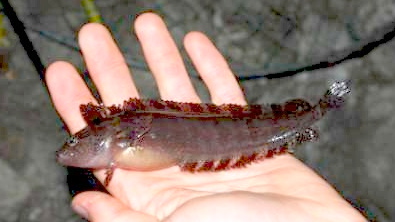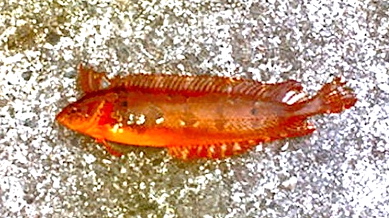California is blessed with a number of attractive little kelpfishes that unfortunately are rarely seen by an angler unless he or she is using small hooks in search of perch. Herein, are several of the smaller species. The Giant Kelpfish, Heterostichus rostratus, is given a different article).
Striped Kelpfish
 Striped Kelpfish from the Malibu Pier
Striped Kelpfish from the Malibu Pier
Species: Gibbonsai metzi (Hubbs, 1927); from Gibbonsai (William P. Gibbons, an early naturalist from Alameda), and metzi (Charles W. Metz, a student of ichthyology once interested in kelpfish).
Alternate Names: Striped kelp-fish, seaweed kelpfish, weed klipfish. Called sargacero or sargacero rayado in Mexico.
Identification: Reddish to light brown, usually with darker stripes or darker mottling on sides (color often matches nearby seaweed). Tail rounded (distinguishes them from a giant kelpfish); pectoral fin is short, not reaching the front of the anal fin.
A kelpfish from the Elephant Rock Pier in Tiburon
Size: To 9 1/2 inches long; most caught off piers are 5-8 inches.
Range: Punta Rompiente, central Baja California to Maquinna Point, Nootka Sound, Vancouver Island, British Columbia.
Habitat: Shallow-water areas near rocks or kelp.
Piers: Found at piers that have a heavy growth of kelp or seaweed. Best bets: I’ve taken them at the Cabrillo Mole (Avalon), the Paradise Cove Pier (Malibu), Coast Guard Pier (Monterey) and the Princeton Harbor Pier. I’ve also taken them at several Bay Area piers including Agua Vista (in San Francisco), Berkeley Pier (East Bay), and Elephant Rock (North Bay). At the first two they were inshore by the rocks, at the latter the pier sits on a rock.
Shoreline: Occasionally taken by anglers fishing in rock or kelp areas if using small hooks.
Boats: An inshore species rarely take from boats.
Kelpfish from the Cabrillo Mole, Avalon, Catalina Island
Bait and Tackle: Light to medium tackle and small, size 8 to 6 hooks. Preferred baits appear to be pieces of worm, blood or pile, while small pieces of shrimp and mussels will also entice them.
Food Value: Too small, let ‘em go.
Comments: A pretty little fish that likes to hang by the rocks, dart out to grab the bait, and then head back to the rocks.
Crevice Kelpfish
 Crevice Kelpfish from the Monterey Coast Guard Pier
Crevice Kelpfish from the Monterey Coast Guard Pier
Species: Gibbonsai montereyensis (Hubbs, 1927); from Gibbonsai (William P. Gibbons, an early naturalist from Alameda), and montereyensis (Monterey, an early collection point for the fish).
Alternate Names: Spotted kelpfish and crevice klipfish. Called sargacero or sargacero de Monterey in Mexico.
Identification: Reddish to brown or lavender; plaincolored to spotted or striped. Dorsal fin soft rays widely spaced at rear of fin. No scales at base of or furher out on the caudal fin. Color variable with several phases, reddish, green, dark and silver bars, which intermix freely; there is usually a strong dark ocellus above the lateral line canal behind the pectoral fin and there may be additionally several series of dark spots of various intensities; fins weakly pigmented at bases, anal and pectorals most so; head often with pigment bars radiating from eye
Size: To 5 ½-inches long; most caught off piers are around 4 inches.
Range: Isla Guadalupe and Bahia San Carlos, central Baja California to Ucluelet, Vancouver Island, British Columbia. Usually north of Point Conception.
Habitat: Shallow-water areas near rocks or kelp. Occurs in inshore rocky areas in algae, usually on exposed coast
Piers: Oceanside Harbor Pier, Cabrillo Mole in Avalon, and the Monterey Coast Guard Pier.
Shoreline: Occasionally taken by anglers fishing in rock or kelp areas if using small hooks.
Boats: An inshore species rarely take from boats.
Bait and Tackle: Light tackle and small hooks. Preferred baits appear to be sea worms—pile worms and bloodworms, pieces of shrimp, and fresh mussels.
Food Value: Too small to be used for food.
Comments: Rarely caught due to their small size. A small fish with a small mouth that is sometimes an incidental catch by perch anglers using small hooks.
Spotted Kelpfish
 Spotted Kelpfish from the Redondo Sportfishing Pier in Redondo Beach
Spotted Kelpfish from the Redondo Sportfishing Pier in Redondo Beach
Species: Gibbonsia elegans (Cooper, 1864); from Gibbonsai (William P. Gibbons, an early naturalist from Alameda), and the Latin word elegans (elegant or handsome).
Alternate Names: Called Sargacero or Sargacero manchado in Mexico.
Identification: Typical kelpfish shape—pointed snout, tiny mouth, rounded caudal fin, and long dorsal fin. Color varies widely; green to brown or tan or reddish—often blotched or streaked. 1-3 (often 2) ocelli on back. Soft rays more widely spaced toward rear of dorsal fin. Scales that extend well onto the caudal fin distinguish it from other kelpfish.
 Kelpfish from the Oceanside Harbor Pier
Kelpfish from the Oceanside Harbor Pier
Size: To 6.2-inches long; most caught from piers are around 4-5 inches.
Range: Bahia Magdalena, southern Baja California, including Isla Guadalupe, to Piedras Blancas Point, central California
Habitat: Shallow-water areas near rocks or kelp. Typically feeds on benthic crustaceans, small mollusks and worms, but also eats fair quantities of algae. Found from subtidal rocky areas to 56 m depth, usually in seaweed. Female lays white eggs in seaweed; male guards egg mass.
Piers: Embarcadero Marina Pier, Oceanside Harbor Pier, Cabrillo Mole in Catalina, Redondo Spotfishing Pier, Malibu Pier, and Monterey Coast Guard Pier.
Shoreline: Occasionally taken by anglers fishing in rock or kelp areas if using small hooks.
Boats: An inshore species rarely take from boats.
Bait and Tackle: Light tackle and small hooks. Preferred baits appear to be sea worms—pile worms and bloodworms, pieces of shrimp, and fresh mussels.
Food Value: Too small to be used for food.
Comments: A small fish that is rarely caught due to their small mouth. However, they are sometimes an incidental catch by perch anglers using small hooks.

















